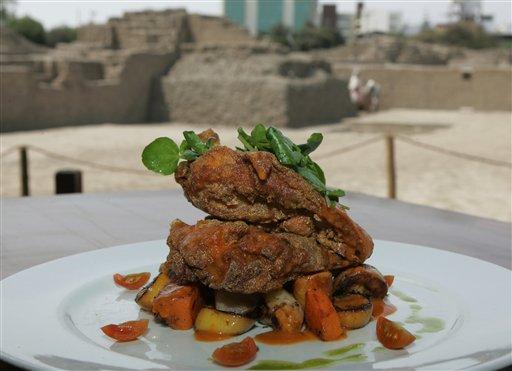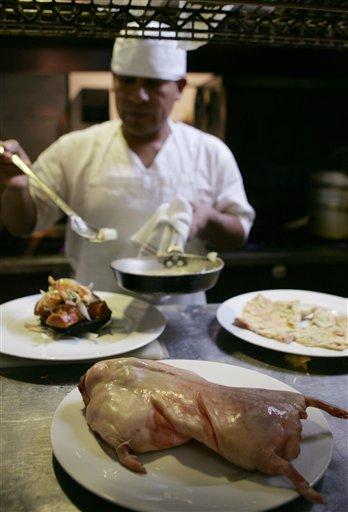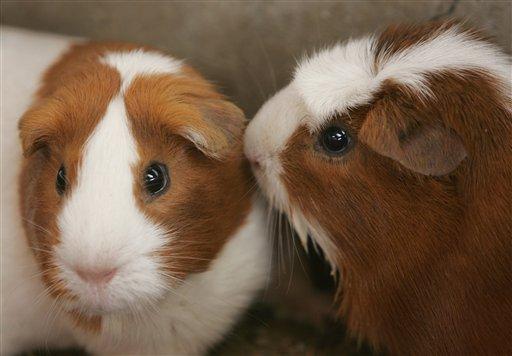Guinea Pigs a Dining Delicacy in Peru
December 21, 2007 - WRAL.com
By LESLIE JOSEPHS, Associated Press Writer
 LIMA, Peru — Ever wonder whether a cabernet sauvignon or merlot
would best complement your childhood pet?
LIMA, Peru — Ever wonder whether a cabernet sauvignon or merlot
would best complement your childhood pet?
(photo-right) A plate of guinea pig meat is seen at the La Huaca restaurant in Lima, Peru, Saturday, Oct. 20, 2007. Guinea pig, a longtime favorite dish of Peru's highland Indians, has made its way into white tablecloth restaurants of Lima. (AP Photo/Martin Mejia)
It might be a dilemma if you visit the coastal Peruvian capital, where chefs have turned guinea pig - a staple protein of the Andes - into a gourmet dish.
Five years ago, chef Marilu Madueno added cuy, as guinea pigs are locally known, to the menu at La Huaca Pucllana, an exclusive Lima restaurant popular with tourists that overlooks a pre-Inca temple.
When she created the restaurant's menu, Madueno correctly guessed that by chopping off the unsightly head and paws - cuy is traditionally served whole in the Andes - it would sell better.
 (photo-left)
A cook serves a plate of guinea pig at the La Huaca restaurant in Lima,
Peru, Saturday, Oct. 20, 2007. Guinea pig, a longtime favorite dish of
Peru's highland Indians has made its way into white tablecloth restaurants
of Lima. (AP Photo/Martin Mejia)
(photo-left)
A cook serves a plate of guinea pig at the La Huaca restaurant in Lima,
Peru, Saturday, Oct. 20, 2007. Guinea pig, a longtime favorite dish of
Peru's highland Indians has made its way into white tablecloth restaurants
of Lima. (AP Photo/Martin Mejia)
"We're seeing cuy ordered more and more," said Madueno, who estimates she sells about 30 a week at about $14 a plate.
She slices off two thin filets of the white, low-fat meat, batters it in wheat flour and fries it until golden. The filets are served on a bed of watercress "to give it a little freshness," with cherry tomatoes and drizzled peanut sauce and bright green cilantro oil. Here in the birthplace of the potato, no plate is complete without a sampling of Peruvian tubers grown high in the Andes: golden mashua and oca, whose colors vary like Indian corn kernels.
Despite the booming popularity of Andean ingredients abroad - especially grains like quinoa - cuy-frites may be a few years from the menus at New York's top restaurants. But the low-cholesterol, high protein white meat may be worth trying. It tastes a bit like a cross between rabbit and dark chicken meat.
"It was delicious. Marinated whole overnight in orange juice and garlic and spit roasted over an open fire," Andrew Zimmern, host of the Travel Channel series Bizarre Foods, said in an e-mail interview. He sampled the delicacy in neighboring Ecuador last year. "Cuy should be popular in the USA once we adopt a different attitude about alternative foods, especially ones that some people keep as pets."
(Adam Goldfarb, an issue specialist in the companion animals department of the Humane Society, said he was not aware of any federal laws prohibiting guinea pig consumption in the United States, but local legislation could vary.)
Guinea pigs are native to the high Andes, and have been an important source of protein for millenia. Today, they are common in rural Andean households as a sort of savings account - they are so easy and cheap to breed, that when a family needs money, they can sell a dozen or so.
 (photo-right) Two Guinea pigs are seen at the Agrarian University in
Lima, Peru, Friday, Oct. 19, 2007. Guinea pig, a longtime favorite dish
of Peru's highland Indians, has made its way into white tablecloth restaurants
of Lima. (AP Photo/Martin Mejia)
(photo-right) Two Guinea pigs are seen at the Agrarian University in
Lima, Peru, Friday, Oct. 19, 2007. Guinea pig, a longtime favorite dish
of Peru's highland Indians, has made its way into white tablecloth restaurants
of Lima. (AP Photo/Martin Mejia)
Guinea pig is often fried or grilled during Andean ceremonies. In Peru, the animal is served with a generous portion of Andean tubers.
One fine Lima restaurant is banking that wildly popular Novo-Andino cuisine - reinvented traditional highland recipes or ingredients - will make cuy as common in Lima as ceviche, raw fish soaked in lime juice and pepper that is Peru's best-known dish.
In May, Victoria Fajardo opened "Senor Cuy" or "Mr. Guinea Pig," a white tablecloth restaurant in the upscale San Isidro banking district whose name speaks for itself.
"We have customers who have eaten cuy their whole lives, but we also have people who come for an adventure," Farjardo said beneath a painting of the Last Supper with Jesus and the 12 disciples eating roasted guinea pig.
Fajardo, a native of the highland state of Ayacucho, says she sells up to 60 guinea pigs a week at around $11 each.
Diners can order cuy by the quarter, half or whole, cooked a dozen ways, spiced authentically according to the traditional recipes of Peru's diverse highland provinces.
Guinea pig cooked in the central Andean Huancayo style is rubbed with Andean herbs - including minty huacatay sauce - battered in flakey quinoa flour and fried in a deep red sauce of Peruvian peppers aji panca and aji mirasol, white wine, cumin and an onion and garlic confit.
"It has almost no fat," said chef Ronald Alburqueque, pointing at the lifeless bucktoothed animal before chopping of its head.
Guinea pig offered whole is the best option as the animal - slaughtered at about three months of age when the meat is still soft - has a bony carcass, which is offset by its thick and flavorful skin.
The menu also includes international interpretations of guinea pig. There's Cuy a la Italiana, with a side of risotto, or Cuy a la Francesa, served with creamed mushrooms and asparagus, and even Cuy a la Americana, roasted guinea pig with a side of French fries.
Peruvians, known for their rich culinary history, are unafraid of something different.
Aurea Basauri, a 50-year-old secretary from Lima, learned to love cuy - head, paws and all - from her husband, who grew up eating it at home.
Other coastal Peruvians will follow suit "if it's served without the head," she said, after ordering an entire fried guinea pig.
Copyright 2007 by The Associated Press. All rights reserved.